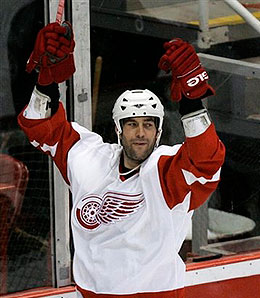Actually, Bill Martin's making.
This latest crisis involving the Michigan football program---the one where players past and present allege NCAA violations in terms of off-season workouts, etc.---is on Martin, the school's fumbling, bumbling Athletic Director.
For it was Bill Martin who so botched up the hiring of Lloyd Carr's successor that he wasn't even able to convince longtime Michigan assistant Les Miles to flee Louisiana State University and come home.
Les Miles should be the coach at Michigan, period.
Miles should have taken over from Carr in a transition that would have been not only a lot smoother, but almost seamless.
Les Miles wanted Michigan, badly. But, amazingly, Michigan didn't seem to want Les Miles in a quid pro quo manner.
Michigan, the Victors Valiant. Michigan, the Leaders of the West. Michigan, the winningest football school in America. Michigan---who let one of their own slip through their fingers.
Martin didn't show Miles nearly enough love upon Carr's exit in 2007.
The following aren't my words, but my sentiment.
Former broadcaster Bob Page, during his appearance on "The Knee Jerks" on July 13---the weekly sports gabfest I have with Big Al on Blog Talk Radio, put it thusly when it came to the Miles debacle.
"All Bill Martin had to do was make one call and say, 'Les, it's time to come home now. We don't care what you're making at LSU. We're not interested in anyone else. We want you to come home now'," Page told us of how Martin's coaching search should have started and ended with Les Miles.
I agree with Page's assessment, 100 percent.
Martin didn't do that. Instead, he publicly stated that Miles was merely one of the candidates Michigan was considering.
Les Miles---a National Championship-caliber college football coach, who cut his teeth at Michigan, wasn't the clear-cut choice to take over from Carr?
Martin screwed up. It got so bad that he couldn't even get Greg Schiano to leave Rutgers.
RUTGERS!!
Martin didn’t go after Miles hard enough, nor quick enough. It should have been a slam dunk—fait accompli. Carr leaves, Miles comes. End of story.
It's likely that Les Miles felt snubbed by Michigan's tentativeness and, when push came to shove, that was enough to convince him that he was best served to stay put in Louisiana.It wasn't the inadequacy of the Wolverines' facilities. It wasn't the inadequacy of the Big Ten, versus the Southeastern Conference. It wasn't the notion of replacing someone as respected as Carr. It was none of those that kept Miles from moving back to Ann Arbor to take over the Michigan football program, as should have been his fate.
It was Bill Martin's wishy-washiness when it came to launching his coaching search---a search that should have taken nothing more than a phone call and the first flight to Baton Rouge to complete.
Now look at what Martin has.
He has almost constant upheaval and a square peg in a round hole---Rodriguez, who still has that outsider feel about him.
But I've said it over and over: you don't blame the peg---you blame the person trying to cram it into place.
It just seems to me that there's too much smoke this time to think there isn't some sort of fire when it comes to these new allegations of NCAA violations, as uncovered by the Detroit Free Press.
There's always going to be attrition when a new football staff takes over a program. That's to be expected. The defection of Justin Boren way back in early 2008, shortly after RichRod took over, could be taken with a grain of salt, because those things happen.
But the Boren instance was just the first of several whispers, both loud and soft, of Rodriguez's way of doing things being looked at with crossed eyes. Again, that happens. But this is Rodriguez's second season and still the university is trying to get out from underneath the transition phase of his hiring.
Something's amiss at Michigan. All these kids, who were recruited to Michigan and who, one would presume, love the school, aren't making this stuff up. The only question will be the severity of the violations, and the consequences.
Would any of this had happened if Les Miles was coaching Michigan?
I don't bet. I don't gamble. But even I as a non-risk taker would shake hands with you and say, comfortably, one word.
No.









